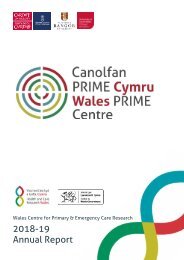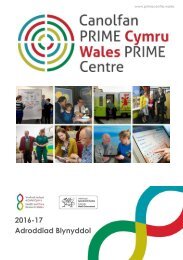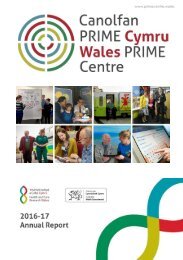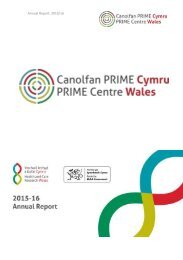You also want an ePaper? Increase the reach of your titles
YUMPU automatically turns print PDFs into web optimized ePapers that Google loves.
Talking about human papillomavirus and cancer: development of consultation guides through lay and<br />
professional stakeholder coproduction using qualitative, quantitative and secondary data.<br />
Human papillomaviruses (HPVs) cause all cervical cancer as well as other cancers. But public awareness of HPV is<br />
poor and many clinicians lack adequate knowledge or confidence to discuss sexual transmission and related<br />
r sit amet,<br />
sensitive issues. In partnership with patients and clinicians we produced a rigorously developed and tested resource<br />
cing elitr, to help sed doctors diam provide HPV information to their patients in a way that is honest, accurate, reassuring and useful.<br />
mpor Hendry invidunt M, Pasterfield ut D, Gollins S, Adams R, Evans M, Fiander A, Robling M, Campbell C, Bekkers MJ, Hiscock J, Nafees S, Rose<br />
agna J, aliquyam Stanley M, Williams O, Makin M, Wilkinson C. Talking about human papillomavirus and cancer: development of consultation<br />
luptua. guides At vero through eos lay and professional stakeholder coproduction using qualitative, quantitative and secondary data. BMJ Open<br />
to duo <strong>2017</strong>;7:e015413. dolores et ea doi: 10.1136/ bmjopen-2016-015413.<br />
asd gubergren, Predictive risk no stratification model: a randomised stepped-wedge trial in primary care (PRISMATIC).<br />
ctus est PRISM Lorem is software which aims to help primary care doctors identify people at high risk of hospital admission, with<br />
et. Lorem the idea ipsum that doctors can then find ways to provide care for those patients at home. We evaluated the effects of<br />
nsetetur introducing sadipscing PRISM into 32 general practices in south <strong>Wales</strong> with a total population of 230,000. Analysing routine<br />
numy data, eirmod we found that, after the introduction of PRISM, there were more emergency admissions to hospital, more<br />
t labore attendances et dolore at accident and emergency, and more outpatient appointments. So, health-care costs rose without<br />
clear evidence of benefits to patients, though a sample of patients we surveyed reported that their physical health<br />
erat, sed diam<br />
had improved.<br />
eos et Snooks accusam H, Bailey-Jones et K, Burge-Jones D, Dale J, Davies J, Evans B, Farr A, Fitzsimmons D, Harrison J, Heaven M, Howson H,<br />
Hutchings H, John G, Kingston M, Lewis L, Phillips C, Porter A, Sewell B, Warm D, Watkins A, Whitman S, Williams V, Russell I T.<br />
Predictive risk stratification model: a randomised stepped-wedge trial in primary care (PRISMATIC). Southampton (UK): NIHR<br />
Journals Library; 20<strong>18</strong> Jan. (Health Services and Delivery Research, No. 6.1)<br />
Detecting the most severe harm experienced by patients: Development and validation of the ?PISA?Primary<br />
Care Patient Safety Harm Severity Classification System.<br />
Worldwide, there is no universally agreed approach to identifying the severity of harm outcomes endure by patients<br />
experiencing unsafe primary health care. We developed a new system, aligned to the World Health Organization?s<br />
(WHO?s) International Classification for Patient Safety, to support the detection and prevention of incidents that<br />
cause the most severe harm to patients.<br />
Cooper J, Williams H, Edwards A, Hibbert P, Parry G, Sheikh A, Donaldson L, Carson-Stevens A. Development and validation of<br />
the ?PISA?Primary Care Patient Safety Harm Severity Classification System. Bulletin of the World Health Organization. 20<strong>18</strong><br />
June.<br />
A methodological solution for leaders to identify and tackle blame in the NHS: Nature of blame in patient<br />
safety incident reports: mixed methods analysis of a national database.<br />
A culture of blame and fear of retribution are recognised barriers to reporting patient safety incidents. To identify<br />
blame in reports describing unsafe care experienced by patients, we developed a framework to quantify the problem<br />
in the NHS. Health service leaders can now use the framework to identify blame cultures in their organisations and<br />
intervene to promote a culture for learning and improvement.<br />
Cooper J, Edwards A, Williams H, Sheikh A, Parry G, Hibbert P, Butlin A, Donaldson L, Carson-Stevens A. Nature of blame in<br />
patient safety incident reports: mixed methods analysis of a national database. Ann Fam Med. <strong>2017</strong> Sep;15(5):455-461. doi:<br />
10.1370/ afm.2123.<br />
Fissure Sealant or Fluoride Varnish? A Randomized Trial of Relative Effectiveness.<br />
Fissure sealant and fluoride varnish are effective in preventing dental caries when compared with a no-treatment<br />
control. However, the relative clinical effectiveness of these interventions is uncertain. The objective of the study<br />
was to compare the clinical effectiveness of FS and FV in preventing dental caries in first permanent molars (FPMs)<br />
in 6- to 7-y-olds. Our finding of equivalence between the caries preventive effect of fluoride varnish and fissure<br />
sealants in a community oral health programme has significant implications for the delivery of such schemes in<br />
areas of social and economic deprivation.<br />
Chestnutt IG, Playle R, Hutchings S, Morgan-Trimmer S, Fitzsimmons D, Aawar N, Angel L, Derrick S, Drew C, Hoddell C, Hood K,<br />
Humphreys I, Kirby N, Lau TMM, Lisles C, Morgan MZ, Murphy S, Nuttall J, Onishchenko K, Phillips C, Pickles T, Scoble C,<br />
Townson J, Withers B, Chadwick BL. Fissure Seal or Fluoride Varnish? A Randomized Trial of Relative Effectiveness. J Dent Res.<br />
<strong>2017</strong> Jul;96(7):754-761. doi: 10.1177/ 0022034517702094.<br />
21

















